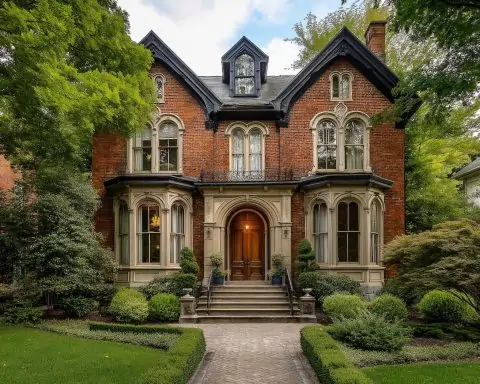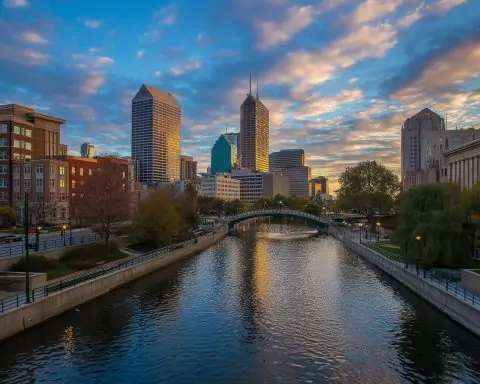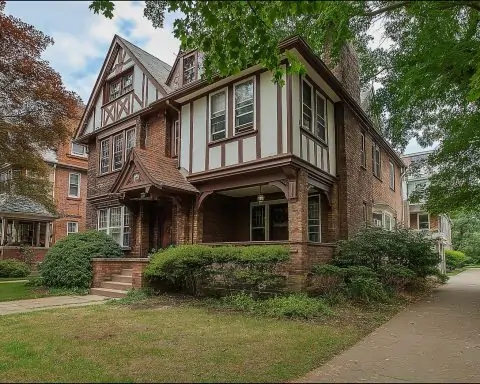- Resilient housing market: In mid-2025 Milwaukee ranked No. 1 among major U.S. metros for housing market strength. Home sales are up ~12% year-over-year and prices about +8.2% mpamag.com. Zillow reports the average home value at ~$219,588 (Aug 2025) and median sale price ~$221,667 (July 2025) zillow.com zillow.com – healthy gains though below explosive Sunbelt growth. Inventory remains tight (roughly a 4-month supply statewide wra.org), keeping Milwaukee a solid seller’s market.
- Rents rising, new supply falling: Milwaukee’s apartment market is extremely tight, with ~95.9% occupancy as of Q4 2024 (among the top 6 US metros) mmgrea.com. Average rents are forecast to rise ~3% in 2025 (peaking ~3.2% in Q3 then ~2.9% year-end) mmgrea.com. However, new multifamily supply is slowing sharply – apartment completions drop from 3,066 units in 2024 to ~1,566 in 2025 (–50%) mmgrea.com. Developers broke ground on only ~1,500 new units in 2024 mmgrea.com. The result: further tightening in 2026–27 as demand outpaces construction.
- Home prices & inventory: Despite strong price gains, Milwaukee home values remain relatively affordable (median around $220K) zillow.com zillow.com. Year-over-year appreciation has moderated to mid-single digits statewide (~5% YoY recently zillow.com). New listings and total inventory are rising slightly (up ~5% YoY statewide in June 2025 wra.org), but still far below balanced levels (only ~4 months’ supply). High mortgage rates keep many owners in place, restraining inventory growth mpamag.com.
- Industrial boom: The industrial/warehouse sector is the hottest in Milwaukee. Q2 2025 net absorption was ~566,000 sf (driven by ~605,000 sf of new deliveries) assets.cushmanwakefield.com. Vacancy remains extremely low (~4.4% overall) assets.cushmanwakefield.com, and overall rental rates (around $5.35/sf NNN) are flat-to-up assets.cushmanwakefield.com. New construction is brisk: 628,000 sf completed in Q2 alone, surpassing all of 2024 assets.cushmanwakefield.com. Notably, speculative projects (e.g. 100K sf pre-leased to Kohl’s) are underway in Waukesha County (Class A vacancy there ~1.5%) assets.cushmanwakefield.com. Data centers (e.g. massive Vantage developments in the region) are also fueling demand assets.cushmanwakefield.com.
- Office market: slow recovery: Downtown and suburban offices are beginning to stabilize. In Q2 2025 the office market saw +86,465 sf net absorption (second straight quarter of gains) assets.cushmanwakefield.com, pulling vacancy down slightly (now ~24.2% overall) assets.cushmanwakefield.com. Class A rents are about $22.65/sf assets.cushmanwakefield.com. Still, overhang remains – older buildings struggle (the 140K sf “Gas Light” building recently foreclosed at just 23% of its assessed value assets.cushmanwakefield.com). The city is encouraging repurposing of vacant offices into housing – for example, the 100 East Wisconsin tower is being converted into ~373 apartments (with ~75 units set aside as workforce housing) city.milwaukee.gov. Office investment is cautious, with tenants delaying space decisions, but key blocks (Third Ward, 5th St) continue mixed-use development.
- Retail/hospitality: The retail sector is relatively weak. Q1 2025 saw –172,527 sf net absorption (vacancy up to ~7.4%) cushmanwakefield.com. Suburban malls and strip centers have high vacancies, though some are being redeveloped. Local supply of hotel rooms is rising: a new 130-room hotel on Brady St and a 162-room Moxy downtown (near Fiserv Forum) are planned finance-commerce.com finance-commerce.com. Convention and entertainment venues are expanding – a $70 M Frank Productions concert hall and a $78 M Milwaukee Rep theater renovation are underway finance-commerce.com – which may boost hospitality demand.
- Major projects and redevelopment: Numerous large projects are reshaping the city. Key examples: the 100 East tower conversion (to 373 apartments, backed by a $14.4 M TIF subsidy) city.milwaukee.gov; New Land Enterprises’ proposed 500-unit apartment development in Bay View/Harbor District (pending TIF approval) biztimes.com; the Edison mass-timber residential tower (32 stories) breaking ground downtown finance-commerce.com; and Granville Station – a planned redevelopment of the former Northridge Mall into mixed-use (housing, retail, industrial) finance-commerce.com. The city also just approved TIDs to spur affordable/workforce housing in Downtown and Bronzeville (e.g. the 67-unit “Compass Lofts” on King Drive, with 56 affordable units city.milwaukee.gov). Even the I-794 freeway is under debate: proposals to rebuild it could free 2,000–3,000 new housing sites finance-commerce.com. Overall, both public and private investments are targeting higher-density, mixed-use developments that add housing and amenities.
- Hot neighborhoods: Emerging growth areas include downtown (particularly the Harbor District and East Side/Marquette area), Walker’s Point/Third Ward, Bay View, and Bronzeville. The Harbor District and Bay View waterfront are being transformed by new residences, eateries, and the Komatsu corporate campus sewartgroup.com. Walker’s Point (just south of downtown) has seen a flurry of apartment conversions and craft breweries sewartgroup.com. Bronzeville (North King Drive) is undergoing a cultural/affordable housing renaissance sewartgroup.com (e.g. recent developments along North Avenue). The Menomonee Valley continues to redevelop as well, with parks, trails and mixed-use projects under the city’s “Valley 2.0” plan. Each of these areas combines historic character with new construction, making them magnets for young professionals and families.
- Economic and demographic drivers: The regional economy is broadening. Milwaukee County added ~3,000 people in 2024 (its first net gain since 2014) wpr.org, largely from international migration. The metro area (including Waukesha) grew ~6,600 in 2024 costar.com. Local unemployment is low (~3.6% in 2025 assets.cushmanwakefield.com). Major employers span advanced manufacturing (Rockwell, Harley-Davidson, Kohler), finance and insurance (Northwestern Mutual, MGIC), healthcare/biotech, and water technology – in fact the region is a global hub for water-related companies mkeregion.com. ChooseMilwaukee notes 18 Fortune 1000 companies in the MKE region mkeregion.com. On the flip side, the city’s median household income (~$52K) and poverty rate (~23%) lag national norms worldpopulationreview.com, highlighting an affordability gap. Overall, steady job base and a young median age (~32) support housing demand, while out-migration pressures (especially among middle-income locals) pose a challenge.
- Investment opportunities and risks: Multifamily and industrial properties offer the strongest returns. Tight rental markets and solid industrial fundamentals (low vacancy, stable rents assets.cushmanwakefield.com) attract investors. New development often leverages incentives (e.g. workforce housing TIFs) to pencil out – unsubsidized rents in new downtown apartments might need to exceed ~$3/sf to break even biztimes.com. On the risk side: office and retail remain under pressure (e.g. the downtown “Gas Light” office building foreclosure assets.cushmanwakefield.com), and construction costs/financing are high. Rising interest rates in 2022–24 slowed new homebuilding; we’re seeing a pullback in urban single-family permits (Milwaukee County YTD is down ~62% wisbuild.org). Even large suburban counties (Waukesha +24.5% YTD) show where builders moved instead. Finally, any economic downturn or policy changes (e.g. immigration) could cool demand.
- 3–5 year outlook: Experts project steady but moderate growth. Housing prices should rise in the mid-single-digits annually (Redfin/MPA noted ~+8.2% by 2025 mpamag.com), with some cooling from 2024’s strength. Rents likely continue ~2–3% annual growth mmgrea.com as long as vacancy stays low. Industrial fundamentals remain robust; expect rental rates to inch up and more speculative projects (data centers, logistics) to proceed. Office rents may slowly rise if vacancy slowly tightens (via conversions), but the sector will likely lag. Neighborhood revitalizations (Downtown, Bronzeville, Bay View) should accelerate population growth and retail/amenity spending. Key drivers to watch: mortgage rates and lending, federal infrastructure/fiscal policy, and the fate of major projects (I-794 plans, GE relocation, etc.). In sum, Milwaukee’s market appears set for continued growth in housing and industrial segments, while commercial real estate adapts through redevelopment – an outlook that investors should calibrate between solid opportunities and caution for weak submarkets.
Sources: Local and industry research (Milwaukee-area REALTORS® and Cushman & Wakefield market reports wra.org assets.cushmanwakefield.com cushmanwakefield.com assets.cushmanwakefield.com; regional builders’ and developers’ data mmgrea.com wisbuild.org; City of Milwaukee planning updates city.milwaukee.gov city.milwaukee.gov; Urban Milwaukee and BizTimes news; Zillow/Redfin data zillow.com mpamag.com; economic analysis from Wisconsin Public Radio and CoStar wpr.org costar.com).












